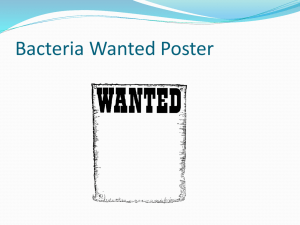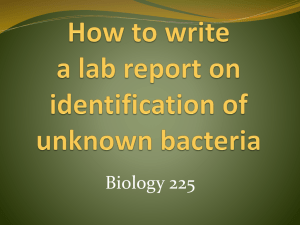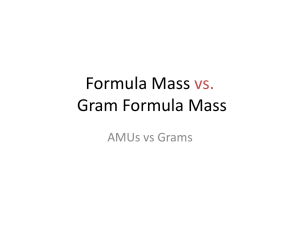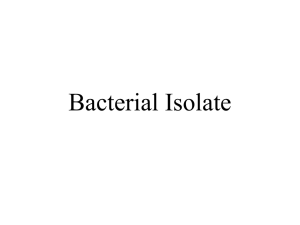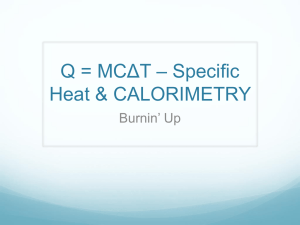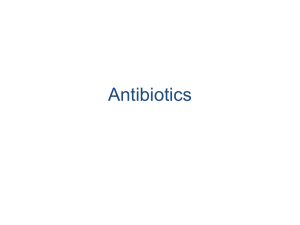PowerPoint Presentation - Lecture 7
advertisement
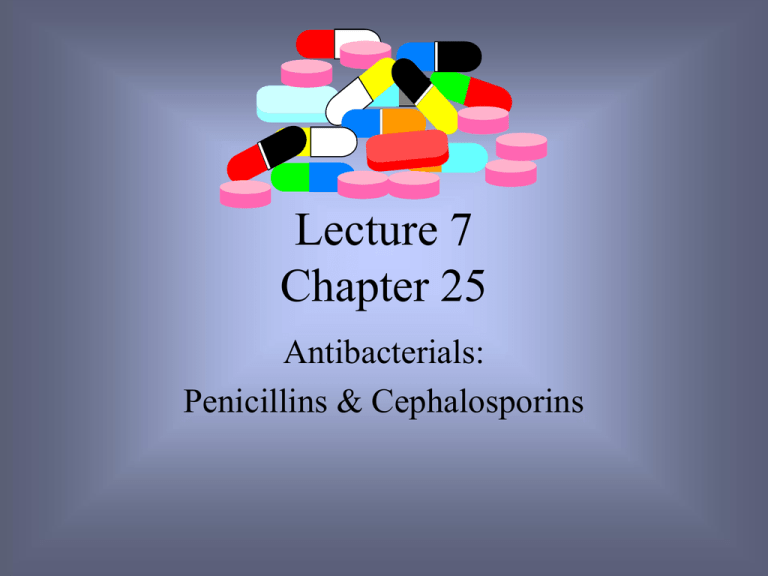
Lecture 7 Chapter 25 Antibacterials: Penicillins & Cephalosporins Antibacterials • Antibacterials/antimicrobial drugs - Substances that inhibit the growth of or kill bacteria or other microorganisms (microscopic organisms = bacteria, viruses, fungi, protozoa) • Bacteriostatic = Inhibits growth of bacteria • Bactericidal = Kills bacteria • Peaks & Troughs = Serum antibacterial levels for drugs w/ a narrow therapeutic index - Too high = drug toxicity (Peak - 1 hr. after drug infused) - Too low = therapeutic range (Trough - before dose) Antibacterials • Mechanism of Action: 1. Inhibition of cell wall synthesis - Bactericidal 2. Alteration in membrane permeability - ‘Cidal’ or ‘Static’ 3. Inhibition protein synthesis - ‘Cidal’ or ‘Static’ 4. Inhibition of bacterial RNA & DNA - Inhibits synthesis of RNA & DNA 5. Interferes with metabolism in the cell - ‘Static’ Antibacterials • Drugs 1. Penetrate bacterial cell wall in sufficient concentrations 2. Affinity to the binding sites on the bacterial cell: - Time drug remains at binding sites = effect - Time controlled by pharmacokinetics Antibacterials • Pharmacodynamics - Concentration at site or exposure time for drug plays an important role in bacteria eradication - Duration of time for use of antibacterial varies according to type of pathogen, site of infection & condition of host - With some severe infections - continuous infusion more effective than intermittent - Body defense & drugs work together to stop infectious process - Effect = drug & host’s defense mechanisms Effects of concentrated drug dosing Antibacterials • Bacterial Resistance - result naturally or may be acquired * Natural (inherent) = w/o previous exposure to antibiotic ie. pseudomonas resistant to Penicillin G * Acquired = prior exposure to antibacterial ie. staph aureus was sensitive to PCN G, now it’s not • Nosocomial infections - infections acquired while clients are in the hosp. Many are mutant strains resistant to many antibacterials Prolonged hospital stay • Antibacterial resistance occurs when antibiotics are used frequently Antibacterials • Culture & Sensitivity - Bld test done to determine effect drugs have on a specific organism Culture = organisms responsible Sensitivity = what antibiotic will work best • Narrow & Broad Spectrum Narrow - primarily effective against 1 type of organism Broad - effective against both gram + & gram - organisms * Used before isolating organism through C & S * Not as effective as narrow spectrum against those single organisms Antibacterials Penicillins (PCN) • From mold genus Penicillium - ‘miracle drug’ from WWII • A beta-lactum structure (beta-lactum ring) interferes w/ bacterial cell wall synthesis by inhibiting the bacterial enzyme necessary for cell division & synthesis • Bacteria die of cell lysis (breakdown) • Both ‘static’ & ‘cidal’ in nature • Mainly referred to as beta-lactum antibiotics (enzymes produced by bacteria that can inactivate PCN Penicillinases = beta-lactamases which attack PCN Antibacterials Penicillins • Natural Penicillins Penicillin G, Penicillin V, Procaine, Bicillin - Good gram +, fair gram - , good anaerobic - PCN G = more effective IV or IM, but painful d/t aqueous solution - PCN V = PO; peak 2 - 4 hrs Antibacterials Penicillins • Aminopenicillins (Broad Spectrum) Amoxicillin (Amoxil), Ampicillin (Omnipen), Bacampicillin HCL (Spectrobid) - Gram + & Gram - Costlier - Inactivated by beta-lactamases = ineffective against Staphylococcus aureus (staph. A) - Amoxicillin = most prescribed PCN derivative for adults & children Antibacterials Penicillins • Penicillinase - Resistant Penicillins Methicillin (Staphcillin), Nafcillin (Unipen), Oxacillin (Bactocil) - Used to treat penicillinase-producing Staph A. - Gram + , not effective against Gram - IV & PO Antibacterials Penicillins • Extended - Spectrum Penicillins Carbenicillin (PO), Mezlocillin, Piperacillin, Ticarcillin, Ticarcillin-clavulanate (Timentin) - IM & IV - Broad spectrum - good gram (-), fair gram (+) - Good against Pseudomonas aeruginosa - Not penicillinase resistant Antibacterials Penicillins • SE & adverse reactions of Penicillins 1. Hypersensitivity - mild or severe Mild = rash, pruritus, & hives - Rx w/ antihistamines Severe = anaphylactic shock - occurs w/ in 20 min. - Rx w/ epinephrine 2. Superinfection - secondary infection when normal microbial flora of the body disturbed during antibiotic Rx Mouth, resp. tract, GI, GU or skin - usually fungus 3. Organ toxicity - esp. liver & kidneys where drugs metabolized & excreted (aminoglycosides) Antibacterials Cephalosporins • From a fungus Cephalosperium acremonium - Gram (+) & gram (-) - Resistant to beta - lactamase - Bactericidal - action similar to PCN’s - 4 groups (generations) - each effective against a broader spectrum of bacteria - about 10% of people allergic to PCN also to allergic to cephalosporins - Action - inhibits bacterial cell wall synthesis - IM & IV - onset = almost immediate Antibacterials Cephalosporins • 1st Generation Cephalosporins - cefadroxil (Duricef) & cephalexin (Keflex) - PO; Cefazolin (Ancef) & cephalothin (Keflin) - IM - Gram (+), & gram (-) - Esp. used for skin/skin structure infections - Keflin used for resp, GI, GU, bone, & joint infections Antibacterials Cephalosporins • 2nd Generation Cephalosporins - cefaclor (ceclor) PO, cefoxitin (Mefoxin), cefuroxime (Zinacef), cefotetan (Cefotan) - IM & IV - Gram (+), slightly boarder gram (-) effect than 1st generation - for harder to treat infections Antibacterials Cephalosporins • 3rd Generation Cephalosporins - cefotaxime (Claforan), ceftazidime (Fortaz), ceftriaxone (Rocephin), cefixime (Suprax) - IM or IV - More effective against gram (-), less effective against gram (+) - for harder yet to treat infections • 4th Generation Cephalosporins - cefepime (Maxipime) - IV or IM - Resistant to most beta-lactamase bacteria - greater gram (+) coverage than 3rd generation Ch. 26 - Antibacterials Macrolides, Lincosamides, Vancomycin • All differ in structure, but similar spectrums of antibiotic effectiveness to PCN • Used as PCN substitutes, esp. w/ people allergic to PCN • Erythromycin frequently prescribed if hypersensitive to PCN • Macrolides - Erythromycin, Azithromycin (Zithromaz), Clarithromycin (Biaxin) - PO/IV, Dirithromycin (Dynabac) PO - Broad spectrum of activity - Low to mod dose = bacteriostatic - high doses = bactericidal SE = GI disturbances, Allergic rxns = Hepatotoxicity Antibacterials Lincosamides • Clindamycin (Cleosin), Lincomycin (Lincorex) PO, IM, IV - Inhibit bacterial protein synthesis - ‘Static’ & ‘cidal’ actions depending on drug dosage - effective against most gram (+), no gram (-) - Clindamycin more effective than lincomycin Antibacterials Vancomycin • Glycopeptide bactericidal antibiotic - IV - Use: Drug resistant Staph A., cardiac surgery prophylaxis for clients w/ PCN allergies - SE = Ototoxicity - damage to auditory branch of 8th cranial nerve permanent hearing loss or loss of balance & Nephrotoxicity - Serum Vanco levels drawn to minimize toxic effects Antibacterials Tetracyclines • Tetracycline, Doxycycline (Vivbamycin), Minocycline (Minocin) - Broad spectrum - Gram (+) & gram (-) bacteria - Bacteriostatic - Wide safety margin, but many side effects - Primarily used for skin/skin structure infections - Also used to treat Helicobacter pylori (H. pylori) bacterium in stomach that can cause peptic ulcers - Tetracycline mostly Antibacterials Tetracyclines • Considerations - SE = Photosensitivity - sunburn rxn - Should not be given to children < 8 yrs or to women in last trimester of pregnancy - Irreversibly discolors permanent teeth - Tetracycline during 1st trimester of pregnancy can cause birth defects - Take on an empty stomach - antacids & dairy products prevent absorption of the drug Antibacterials Aminoglycosides • Amikacin (Amikin), Gentamicin (Garamycin), Tobramycin (Nebcin), Netilmicin (Netromycin) - Inhibits bacterial protein synthesis, ‘cidal’ - Gram (-) & some gram (+) - Used to treat serious infections - Cannot be absorbed from GI tract, cannot cross into CSF - To ensure a desired bld level - IV use - Narrow therapeutic range - Peak & Trough levels drawn - SE = Ototoxicity, Nephrotoxicity Antibacterials Fluoroquinolones (Quinolones) • Ciproflaxacin (Cipro), Levofloxacin (Levaquin), Ofloxacin (Floxin), Norfloxacin (Noroxin) - IV or PO - Interferes w/ synthesis of bacterial DNA - Bactericidal - Broad spectrum - gram (-) & gram (+) - Rx - UTI’s, lower resp. infections, bone & joint infections, GI, skin - Wide safety margin - CI - Children < 14 yrs Chapter 27 Sulfonamides • One of the oldest - broad spectrum - gram - & gram + • First group of drugs used against bacteria • Bacteriostatic - inhibits bacterial synthesis of folic acid, essential for bacterial growth • Alt. for people allergic to PCN • Use - UTI’s, ear infections, newborn eye prophylaxis - Not effective against viruses or fungi • PO, sol’n & ointment for ophthalmic use & cream - Silver sulfadiazine (Silvadene) - for burns Antibacterials Sulfonamides • Special consideration - Drink fluids to prevent crystalluria (d/t poor water solubility) & hematuria • SE - allergic response - skin rash & itching - Anaphylaxis not common - Bld disorders w/ prolonged use & high doses - GI disturbances - Photosensitivity Chapter 28 Antitubercular, Antifungal Peptides, & Metronidazole • Inhibit or kill organisms that case diseases • Tuberculosis (TB) - Caused by the acid-fast Bacillus Mycobacterium tuberculosis - frequently referred to as the tubercle bacillus - One of the major health problems in the world & kills more people than any other infectious disease - About 11/2 billion people have TB & don’t know it - TB in US until 1980’s & AIDS d/t compromised immune system Antiinfective Agents Tuberculosis • Transmitted by droplets dispersed in the air through coughing & sneezing inhaled into alveoli (air sacs) of lungs spread to other organs via blood & lymphatic system - Strong system = phagocytes stop multiplication of tubercle bacilli - Compromised system = tubercle bacilli spread Antiinfective Agents Tuberculosis • Drugs: Isoniazid (INH) - 1952, Rifampin - Prophylactic therapy for persons close to TB, HIV +, a + TB skin test, young children in contact w/ active TB, - Family members on Isoniazid 6 months to 1 yr - Spectrum = Myobacterium tuberculosis, ‘cidal’ - Combo of Isoniazid & Rifampin = No bacterial resistance & less Rx time = more effective - SE = ‘flu-like’ symptoms, neurotoxicity, hepatotoxicity, Monitor drug therapy carefully Antiinfective Agents Antifungals (Antimycotics) • Topical - skin/mucus membranes (athletes foot) • Systemic - lung, CNS (pulmonary conditions, meningitis) • Fungi - Candida (yeast) - normal flora of mouth, skin, intestine, vagina • Candidiasis = opportunistic infection - body’s defense mechanism impaired allowing overgrowth of fungus • Drugs - antibiotics, contraceptives & immunosuppressives may alter body’s defense mechanisms - mild = vaginal yeast infection, severe = systemic infect. Antiinfective Agents Polyenes • Amphotericin B (Fungizone), Mystatin (Mycostatin) • Broad spectrum antifungal activity • Fungizone = IV administration SE = Flushing, chills, N & V, dec. BP Considered highly toxic - nephrotoxicity & electrolyte imbalance poss • Nystatin = orally or topically for candidal infections Swish & swallow to allow contact w/ mucus membranes Antiinfective Antifungal • Metronidazole (Flagyl) - treatment of various disorders associated w/ organisms of GI tract - PO and IV • SE = GI discomfort, Headache, depression (not common) • Also used to treat H. pylori associated w/ peptic ulcers Math Problems A dose of 200 mcg is ordered. The strength available is 0.3 mg. in 1.5 mL. Convert mg to mcg. 1 mg = 1000 mcg 0.3 mg = 300mcg 200 mcg X 1.5 ml. = X ml 300 mcg 2 3 X 1.5 = 3 3 = X = To give 200 mcg you must administer 1 ml. 1 ml A dosage of 0.7 g. has been ordered. Available is a strength of 1000 mg. in 1.5 mL. Convert g. to mg. 0.7 g = 700 mg 700 mg. X 1000 mg. 7 10 X 1.5 mL = X mL 1.5 mL = 10.5 10 = 10.5 divided by 10 = 1.05 Round up to 1.1. So administer 1.1 mL. X
